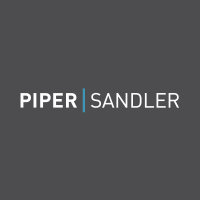
Piper Sandler Companies
NYSE:PIPR


| US |

|
Johnson & Johnson
NYSE:JNJ
|
Pharmaceuticals
|
| US |

|
Berkshire Hathaway Inc
NYSE:BRK.A
|
Financial Services
|
| US |

|
Bank of America Corp
NYSE:BAC
|
Banking
|
| US |

|
Mastercard Inc
NYSE:MA
|
Technology
|
| US |

|
UnitedHealth Group Inc
NYSE:UNH
|
Health Care
|
| US |

|
Exxon Mobil Corp
NYSE:XOM
|
Energy
|
| US |

|
Pfizer Inc
NYSE:PFE
|
Pharmaceuticals
|
| US |

|
Palantir Technologies Inc
NYSE:PLTR
|
Technology
|
| US |

|
Nike Inc
NYSE:NKE
|
Textiles, Apparel & Luxury Goods
|
| US |

|
Visa Inc
NYSE:V
|
Technology
|
| CN |

|
Alibaba Group Holding Ltd
NYSE:BABA
|
Retail
|
| US |

|
3M Co
NYSE:MMM
|
Industrial Conglomerates
|
| US |

|
JPMorgan Chase & Co
NYSE:JPM
|
Banking
|
| US |

|
Coca-Cola Co
NYSE:KO
|
Beverages
|
| US |

|
Walmart Inc
NYSE:WMT
|
Retail
|
| US |

|
Verizon Communications Inc
NYSE:VZ
|
Telecommunication
|
Utilize notes to systematically review your investment decisions. By reflecting on past outcomes, you can discern effective strategies and identify those that underperformed. This continuous feedback loop enables you to adapt and refine your approach, optimizing for future success.
Each note serves as a learning point, offering insights into your decision-making processes. Over time, you'll accumulate a personalized database of knowledge, enhancing your ability to make informed decisions quickly and effectively.
With a comprehensive record of your investment history at your fingertips, you can compare current opportunities against past experiences. This not only bolsters your confidence but also ensures that each decision is grounded in a well-documented rationale.
Do you really want to delete this note?
This action cannot be undone.

| 52 Week Range |
162.0553
348.81
|
| Price Target |
|
We'll email you a reminder when the closing price reaches USD.
Choose the stock you wish to monitor with a price alert.

|
Johnson & Johnson
NYSE:JNJ
|
US |

|
Berkshire Hathaway Inc
NYSE:BRK.A
|
US |

|
Bank of America Corp
NYSE:BAC
|
US |

|
Mastercard Inc
NYSE:MA
|
US |

|
UnitedHealth Group Inc
NYSE:UNH
|
US |

|
Exxon Mobil Corp
NYSE:XOM
|
US |

|
Pfizer Inc
NYSE:PFE
|
US |

|
Palantir Technologies Inc
NYSE:PLTR
|
US |

|
Nike Inc
NYSE:NKE
|
US |

|
Visa Inc
NYSE:V
|
US |

|
Alibaba Group Holding Ltd
NYSE:BABA
|
CN |

|
3M Co
NYSE:MMM
|
US |

|
JPMorgan Chase & Co
NYSE:JPM
|
US |

|
Coca-Cola Co
NYSE:KO
|
US |

|
Walmart Inc
NYSE:WMT
|
US |

|
Verizon Communications Inc
NYSE:VZ
|
US |
This alert will be permanently deleted.
 Piper Sandler Companies
Piper Sandler Companies
Piper Sandler Companies
Piper Sandler Companies has carved out a distinctive niche in the financial landscape as a leading investment bank and institutional securities firm. With its roots tracing back to 1895, this Minneapolis-headquartered company has built a robust reputation through decades of adapting to economic cycles and market shifts. Piper Sandler specializes in providing investment banking, equity research, public finance, and fixed income services aimed at facilitating complex transactions for its clients. Its clientele comprises corporations, institutional investors, public entities, and nonprofits, all of which rely on Piper Sandler's deep industry expertise and bespoke advisory services to navigate the intricate world of finance and make strategic, informed decisions.
The way Piper Sandler generates revenue is multifaceted, reflecting the breadth of its services. Its investment banking operations, which include financial advisory and underwriting services, play a pivotal role in its financial success. Fees from advising on mergers and acquisitions, restructuring, and equity and debt offerings contribute significantly to the company's income. Additionally, the institutional brokerage segment, which provides access to research, trading, and market-making services, serves as a steady income stream through commissions and trading profits. By leveraging its extensive networks and experienced teams, Piper Sandler successfully capitalizes on market opportunities, demonstrating resilience and innovation in a competitive industry.

Piper Sandler Companies has carved out a distinctive niche in the financial landscape as a leading investment bank and institutional securities firm. With its roots tracing back to 1895, this Minneapolis-headquartered company has built a robust reputation through decades of adapting to economic cycles and market shifts. Piper Sandler specializes in providing investment banking, equity research, public finance, and fixed income services aimed at facilitating complex transactions for its clients. Its clientele comprises corporations, institutional investors, public entities, and nonprofits, all of which rely on Piper Sandler's deep industry expertise and bespoke advisory services to navigate the intricate world of finance and make strategic, informed decisions.
The way Piper Sandler generates revenue is multifaceted, reflecting the breadth of its services. Its investment banking operations, which include financial advisory and underwriting services, play a pivotal role in its financial success. Fees from advising on mergers and acquisitions, restructuring, and equity and debt offerings contribute significantly to the company's income. Additionally, the institutional brokerage segment, which provides access to research, trading, and market-making services, serves as a steady income stream through commissions and trading profits. By leveraging its extensive networks and experienced teams, Piper Sandler successfully capitalizes on market opportunities, demonstrating resilience and innovation in a competitive industry.






























 You don't have any saved screeners yet
You don't have any saved screeners yet
